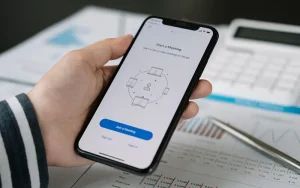Parkinson’s disease, a prevalent neurodegenerative condition globally, leads to motor issues like tremors, slow movement, stiffness, and balance problems. Memory decline may also occur over time. Due to the unpredictable nature of the disease, experts advise regular monitoring to promptly address symptom changes.
New tech tools aim to enhance communication among doctors, caregivers, and patients, improving care. In the ParkProReakt project, researchers from the Fraunhofer Institute for Applied Information Technology FIT are developing a digital platform and app, along with wearable devices, to monitor disease progression and enhance the lives of Parkinson’s patients.
In Germany alone, there are approximately 400,000 individuals living with Parkinson’s disease. While medications can alleviate symptoms, a cure remains elusive. The gradual loss of specific cells responsible for movement execution results in increasing movement limitations and rest tremors in the hands and feet.
For many patients, accessing medical care poses a challenge, particularly in rural regions where long distances to doctor’s offices are common. Consequently, patients may only receive medical attention every six months or even less frequently. Often, new symptoms are overlooked by patients and their caregivers, leading to gaps in information provided to the medical team.
In the ParkProReakt flagship initiative, researchers from the Fraunhofer Institute for Applied Information Technology FIT and various partners aim to facilitate continuous communication between healthcare providers and patients, enabling regular check-ups. The project consortium, which includes Philipps-Universität Marburg, Justus Liebig University Giessen, Praxis für Neurologie und Psychiatrie Hamburg Walddörfer, AWO Stadtkreis Giessen e. V., AWO des Landesverband Hamburg e. V., Techniker Krankenkasse, Technische Hochschule Mittelhessen, University of Cologne, Universität zu Lübeck, LiKe Research GmbH, and Portabiles Health care Technologies GmbH, is exploring the potential of digital solutions to enhance the quality of life for Parkinson’s patients. Coordination of the project is managed by the neurology team at Philipps-Universität Marburg, with the initiative scheduled to continue until the end of 2025.
A care model driven by demand and embracing a holistic approach
Through the development of a web platform and a mobile app, which syncs with an Apple Watch via Bluetooth, the partners aim to establish a proactive, demand-responsive, interdisciplinary care model that involves healthcare professionals and specialists interacting on the platform. The primary objective is to enhance patient care and alleviate some of the burdens faced by family caregivers, as the digital solution aids in monitoring changes in the disease’s progression.
“The app, named Active PD, is intended for patient use following an initial orientation phase. Data collected through the app are transmitted to the web platform accessible to doctors,” explains Daniel Wolferts, a researcher at Fraunhofer FIT.
Wolferts and his team are tasked with the human-centric design of both systems, among other responsibilities. They are focused on creating a user interface that is intuitive and user-friendly.
“We’re addressing questions like: How can we create an app tailored to Parkinson’s patients, and what specific information are they seeking? How do we present data in both applications in a way that’s easy to understand for all involved groups, and how do we meet their needs efficiently? Additionally, how can we enable patients to undergo required tests and assessments directly on their phones, minimizing motor challenges? These are the key issues we’re tackling.”
Read More : Air pollution heightens Parkinson’s risk with genetic influence
Clinical trial involving 170 participants
The effectiveness of the concept is being assessed through a clinical trial involving 170 patients over six months. One group will receive the digital solution, while another will undergo traditional treatment without additional technological aids.
Patients are instructed to perform standardized Parkinson’s-related tests twice weekly using the app and the Apple Watch, which captures their movements via sensors. These tests primarily assess motor skills and overall condition, aiding healthcare providers in understanding disease-related symptoms and facilitating prompt intervention.
For instance, participants are prompted to perform finger exercises in front of the smartphone camera, repeatedly tapping their index finger and thumb together as quickly as possible. An image recognition feature identifies the thumb and forefinger and measures the distance between them during the exercise.
Another exercise entails rapidly opening and closing the fist several times. “Parkinson’s patients often struggle to perform these movements quickly and smoothly due to the disease,” explains the researcher. Additionally, sensors monitor participants’ ability to maintain a steady hand position without trembling—a common challenge for those with Parkinson’s disease.
The tests are complemented by inquiries about patient well-being, allowing emotional support to be offered as needed. Three color codes—green, yellow, and red—alert the treating physician to significant deteriorations in a patient’s condition.
The app, currently in the prototype phase, also enables users to report incidents such as falls.
“We aim for our digital solution to offer healthcare providers better insights into patients’ daily lives and to positively impact their quality of life. If successful, we may expand the concept to address other neurological conditions in the future,” says Wolferts.










